A Day at Esalen 2
Last weekend I was lucky enough to visit Esalen, in Big Sur, and take a class that was facilitated by my friend, permaculture activist and educator Kat Steele. The class was called “Ecoliteracy in Action,” and is part of an ongoing series that features people who are making a difference in their daily acts. How wonderful to spend the day in the beautiful Esalen garden and hear from some like-minded folks.
First we heard from Emily Frost, a teacher who has been working in the Gazebo School at Esalen this summer. This is a unique school that serves young children in the area, and also children of people who are taking workshops or working at Esalen. So kids can be there for as short as one day, or as long as six years. It’s an outdoor classroom, and has a philosophy that honors a child’s individual need to explore, discover, learn to rely on themselves, work things out with others, and test their limits.
She talked about their hands-off approach, letting children decide what they wanted to participate in, and how the teachers were conscious of their impact of modeling relationships. This was so refreshing to me at a time where curriculum is getting more and more standardized at a younger age for so many children. I feel fortunate that my son was able to explore in nature at a young age and develop confidence in his own abilities. I wish that for so many more children.
After hearing about the school, we moved from the yurt to the garden, and heard from Robin Burnside, the author of The Homesteader’s Kitchen. When we had all shared what attracted us to this class at the beginning, Robin had said that her action was in how she lived her life, how she cared for the land she lived on and her family (I am so paraphrasing here.) She also shared her experience with the Gazebo School where all her kids were raised.
She set up her Vita-mix on a table in the garden, and proceeded to make some great pestos and spreads, with some useful tips about how she integrated them into her daily life.
Some of the things we talked about: different times for soaking seeds to get rid of enzyme inhibitors. (Seeds have resistance to being digested, so they can pass through a bird’s digestive tract, for example, and still grow) How her kids got more lasting energy from concentrated greens than turkey while surfing for hours. Blenders and food processors. And much, much more.
Everybody helped.
We made 3 kinds of pesto: basil, arugula, and italian parsley (pictured, top to bottom). I really liked the arugula which was so sweet, we forgot to add the garlic. The greens were so fresh!
I really appreciated Robin’s stories and got such a strong sense of her relationship to the land that she lives on, and to the whole local community. Big Sur is not the easiest place to live, and those who are able to live there who aren’t rich are deeply committed to stewardship of the land.
Robin also brought her awesome kraut, one kind had beets and the other some sea vegetables, I think. After much tasting, it was time to lie down in the grass and listen to Branan Freeman talk about prayer flags.
Branan is an art teacher. Can you tell? She started by talking about meditating on and praying for the Rights of Nature.
Rights of Nature is the recognition and honoring that Nature has rights. It is the recognition that trees, oceans, animals, mountains have rights just as human beings have rights. Rights of Nature is about balancing what is good for human beings against what is good for other species, what is good for the planet as a world. It is the wholistic recognition that all life, all ecosystems on our planet are deeply intertwined.
This movement seems so hopeful to me and I hope it keeps gaining steam. Branan also shared how prayer flags originated in pre-buddhist Tibet, and how, as the flags get frayed, the prayers get spread by the wind to bring benefit to all.
From wikipedia:
The prayers of a flag become a permanent part of the universe as the images fade from exposure to the elements. Just as life moves on and is replaced by new life, Tibetans renew their hopes for the world by continually mounting new flags alongside the old. This act symbolizes a welcoming of life’s changes and an acknowledgment that all beings are part of a greater ongoing cycle.
Branan also talked about the order of the flags, blue for sky, white for cloud (mystery, question), red for fire, green for water and yellow for earth. She had dyed the white fabric she had with natural dyes, and they had faded when she hung them up to dry, which was fine with us, another symbol of the transitory nature of the universe.
So we created our flags, using the many art materials spread out, and picking some from the garden and trees around us.
A family on retreat came by and joined in:
Here are some of the finished flags:
The last step was to string together the flags, sewing them on to a piece of string in the right order, allowing room for the ties, and about a hands distance between each flag:
What a beautiful day in the garden!
This is an ongoing class that runs monthly, though I’m not sure how long it will be running for. It’s a really good opportunity to visit Esalen for the day. I think this class is larger than the sum of its parts. The real gift of the class and the environment at Esalen is the conversation that arises that honors the search for a life with meaning.
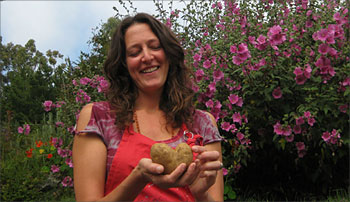



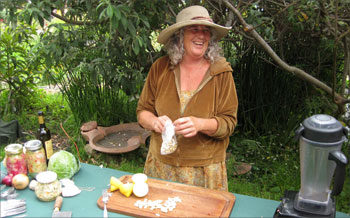
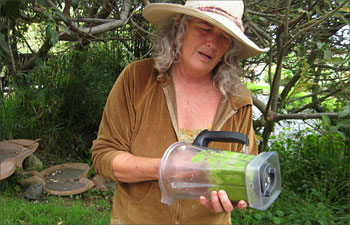
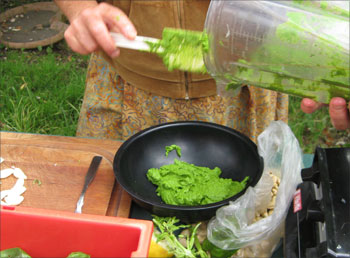





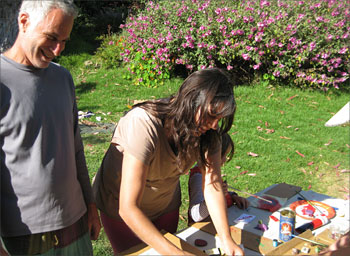


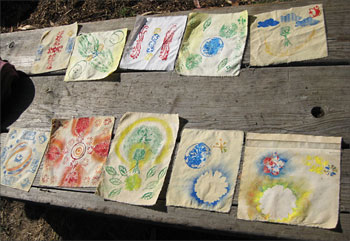


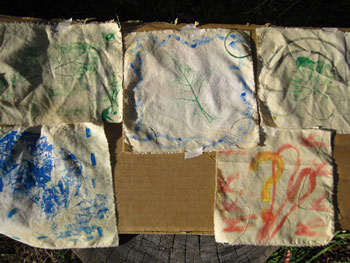
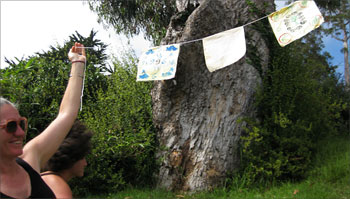

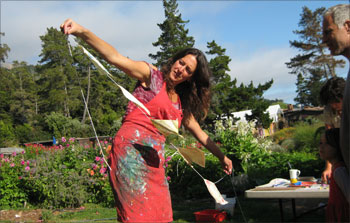


What a lovely way to spend the day! …with creativity, nature, and food for thought and for the soul.
Looks like a beautiful place and lovely day. The flags make great bunting.